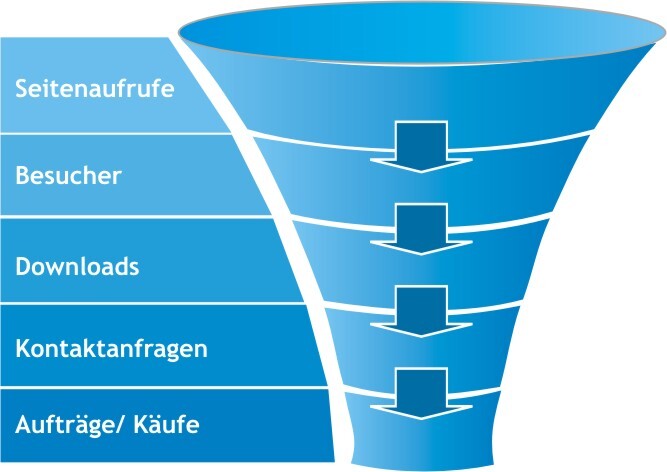Mobile Marketing: Mobile Funnel zur Kundengewinnung
Das mobile Internet ist mittlerweile die am häufigsten genutzte Internetplattform unter den Nutzern. Mobile Marketing ist daher für Unternehmen ein relevantes Online-Marketing- Instrument. Käufe über Smartphone und Tablet haben in den letzten Jahren stetig zugenommen, siehe: ARD/ZDF-Onlinestudie 2020 .
Dieser Artikel zeigt dir das Potenzial und die Herausforderungen beim Aufbau eines mobilen Verkaufstrichters sowie Empfehlungen, wie Vermarkter mobile Touchpoints einrichten können.
Mobiles Marketing durch zunehmende Smartphone-Nutzung
Smartphones dominieren heute unsere Online-Nutzung. Wir nutzen sie, um Nachrichten abzurufen und Unterhaltung zu genießen. Wir sind rund um die Uhr online und können sofort auf alles reagieren, auch über die Verbindung zu sozialen Netzwerken.
Ob in der Bahn, im Bus oder vor dem Fernseher: Dank Flatrates und WLAN ist Surfen überall und jederzeit möglich. Dies hat zu einem dramatischen Anstieg der mobilen Internetnutzung geführt. Im Jahr 2019 nutzten 74 Prozent der Deutschen das Internet hauptsächlich über mobile Geräte, siehe Statista-Zahl.

Herausforderungen im Mobile Marketing
Wie jede Marketingmaßnahme muss auch das Mobile Marketing gewisse Herausforderungen meistern. In Kombination mit Content Marketing und Social Media Marketing lassen sich Nutzer zwar gezielt ansprechen, doch steigen auch die Erwartungen der Kunden an das mobile Internet. So muss eine Website auf mobilen Geräten schnell laden und gut lesbar und navigierbar sein.
Für Google zählt für die Ranking-Sichtbarkeit nicht mehr nur SEO, sondern auch die mobile Seitengeschwindigkeit. Hinzu kommen Faktoren jenseits mobiler Standards wie Responsive Design, spezielle Anzeigen und die Nutzung sozialer Medien. Der mobile Kanal wird zum ersten Kontaktpunkt für Kunden, da diese zunehmend auch zu Hause ihr Mobiltelefon nutzen.
Mobiler Sales Funnel für den Einkauf mit dem Handy
Ein Sales Funnel ist ein wesentlicher Bestandteil jeder Marketingmethode. Er beginnt meist breit angelegt, um Aufmerksamkeit zu gewinnen. Anschließend werden die Maßnahmen fokussierter: von Seitenaufrufen über Besucher und Downloads bis hin zu Kontakten und Bestellungen bzw. Käufen. Siehe Grafik: Volker Wendeler, CC BY-SA 3.0.

Mobile Marketing-Anforderungen für den mobilen Verkaufstrichter
Damit diese Umstellung im Mobile Marketing funktioniert, müssen drei Voraussetzungen erfüllt sein:
- Offline und Online kombinieren : Laufen Offline-Kampagnen wie Plakate oder TV-Spots, können diese mit Online-Informationen verknüpft werden, beispielsweise auf Plakaten mit QR-Codes. So können Marketer über WLAN-Tracking Informationen über die Nutzer sammeln. Parallel kann Google AdWords genutzt werden, um die Kampagne online zu schalten, Social-Media-Marketing zu betreiben und Touchpoints in den Netzwerken zu etablieren.
- Inhalte an Nutzerbedürfnisse anpassen : Kunden suchen bei Google meist schnell und stichwortbasiert nach Lösungen. Unternehmen sollten darauf achten, dass Website und Inhalte so gestaltet sind, dass sie sofort Lösungen und Antworten bieten. Einträge in Google MyBusiness sind vorteilhaft, wenn Nutzer nach Geschäften, Restaurants oder Arztpraxen in ihrer Nähe suchen. Telefonnummern und E-Mail-Adressen sollten direkt vom Handy aus anklickbar sein, ohne dass ich sie mir erst notieren muss. Auch die Sprachsuche erfreut sich zunehmender Beliebtheit, wobei immer mehr W-Fragen gestellt werden. Was läuft heute im Kino? Wo gibt es Topflappen? Um nur zwei Beispiele zu nennen. Idealerweise gibt es auf deiner Website Elemente, die wie FAQs aufgebaut sind und diese W-Fragen beantworten. So rückt sie für Google in den Fokus.
- Mobile Usability : Eine Website, die auf mobilen Geräten lange zum Laden braucht, anfangs mit Werbung vollgestopft ist, zu große oder zu kleine Bilder enthält und umständliches Scrollen erfordert, verliert viele Nutzer schon in den ersten Sekunden – wahrscheinlich für immer. Unternehmen müssen daher auf Ladezeiten achten; idealerweise sollten diese drei Sekunden nicht überschreiten. Buttons und Links müssen gut sichtbar sein, was wiederum den weiteren Verlauf des Sales Funnels unterstützt.
Tipps: Mobile Funnel-Prozesse einrichten
Es gibt drei Möglichkeiten, Verkaufstrichter im mobilen Marketing zu entwerfen und zu implementieren.
- Akquisitionstrichter : Hierbei geht es darum, Ihre Zielgruppe genau zu identifizieren. Dies beginnt mit kundenrelevanten Inhalten gepaart mit kostenlosen Inhalten, wie beispielsweise einem kostenlosen E-Book oder einer kostenlosen Checkliste als Eisbrecher. Dies trägt wiederum zur Expertenpositionierung bei. Auch ein Quiz ist hier möglich, das beispielsweise auf der Website oder über Social Media geteilt werden kann. Die Daten helfen dabei, die Zielgruppe besser zu verstehen und zu definieren.
- Interaktionstrichter : In der nächsten Phase geht es darum, das Vertrauen Ihrer Zielgruppe zu gewinnen. Erklärende Inhalte, wie beispielsweise Crashkurse oder How-to-Videos, die den Nutzern Ihre Produkte oder Dienstleistungen erklären, eignen sich hierfür hervorragend. Dies lässt sich problemlos über die Website, Mailings oder auch Social Media erreichen.
- Conversion Funnel : Im letzten Schritt geht es darum, einen Kauf abzuschließen und die Kundenbindung zu stärken. Der in den vorherigen Phasen gewonnene Traffic soll Kunden bringen, was durch gezielte Kommunikation erreicht wird. Stell eine konkrete Angebotsanfrage oder schlag eine Terminvereinbarung vor, z. B. für eine kostenlose Strategieberatung oder einen Produkttest. Je besser das Angebot durch die vorherigen Phasen auf den Nutzer zugeschnitten ist, desto wahrscheinlicher ist es, dass es zu einem Kauf führt.
Fazit : Eine klar abgestimmte mobile Website, zugeschnitten auf Kundenbedürfnisse und aktuelles Nutzerverhalten, steigert dein Online-Geschäft deutlich. Neue Technologien wie Augmented und Virtual Reality unterstützen dies zusätzlich. Weiterlesen: ARD/ZDF-Onlinestudie 2020 .
Wir unterstützen dich gerne bei deiner Mobile Marketing- und Mobile Sales-Strategie. Schreib uns einfach eine E-Mail .
Verpass keinen Blogbeitrag! Abonniere unseren Newsletter!
Abonniere unseren Newsletter zum Thema Digitales Marketing!
Verpasse keinen Blogbeitrag zu den Themen Social Media, Content Marketing, LinkedIn-Marketing und Automatisierung!